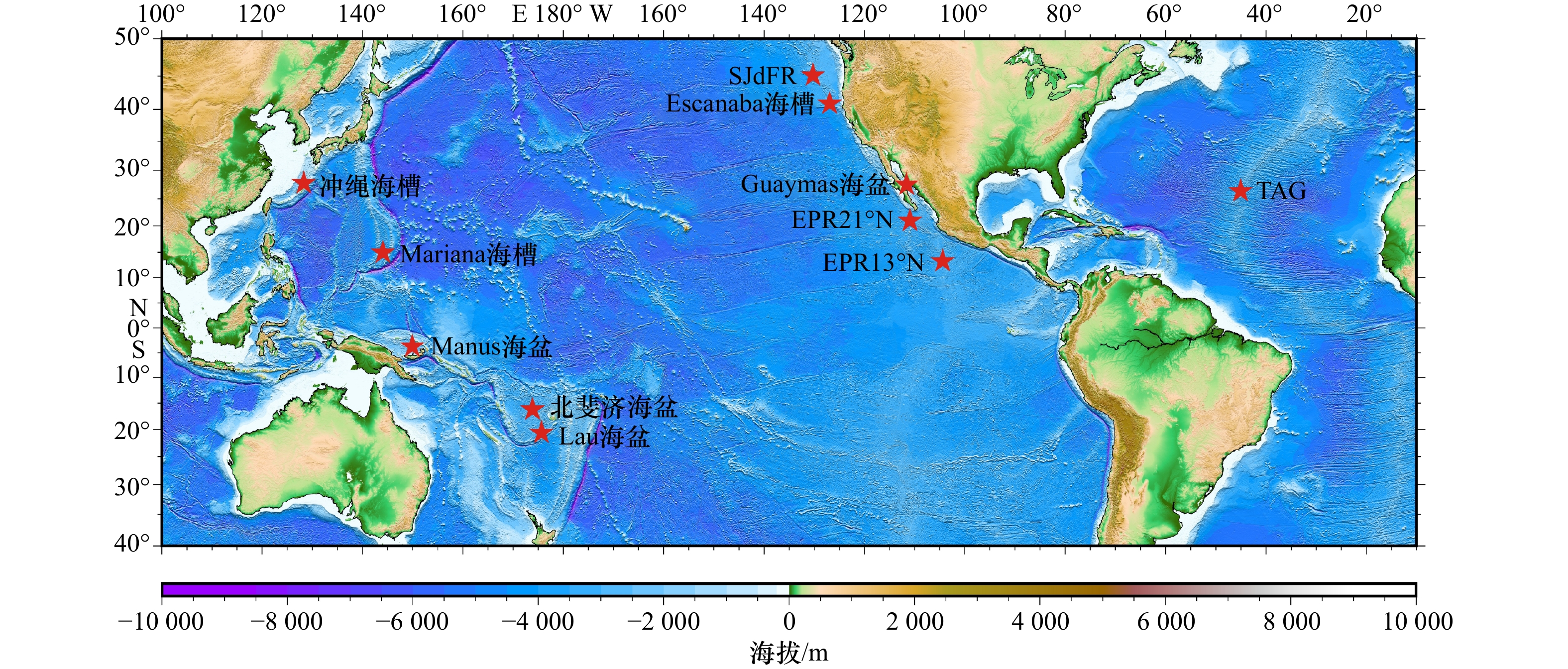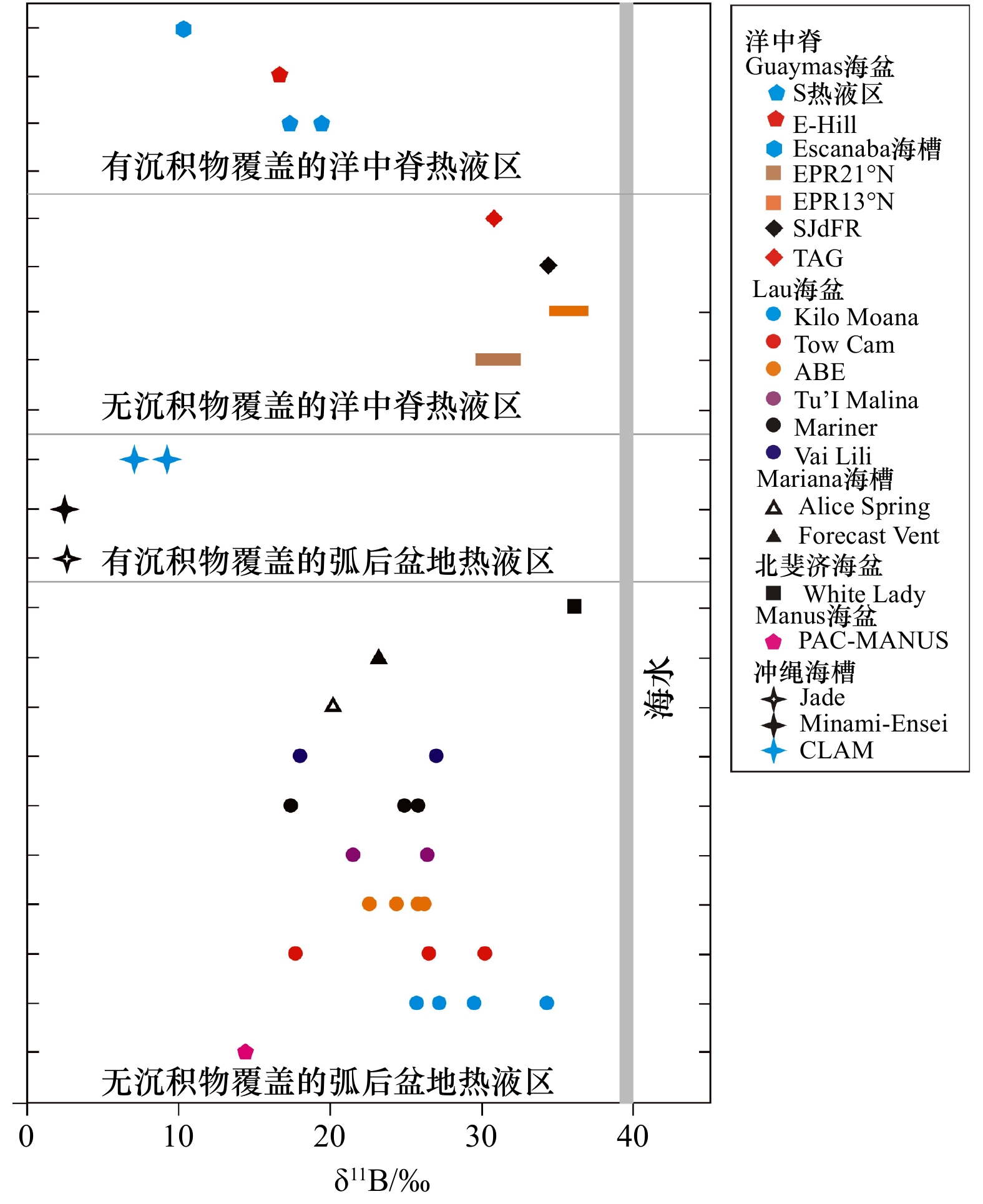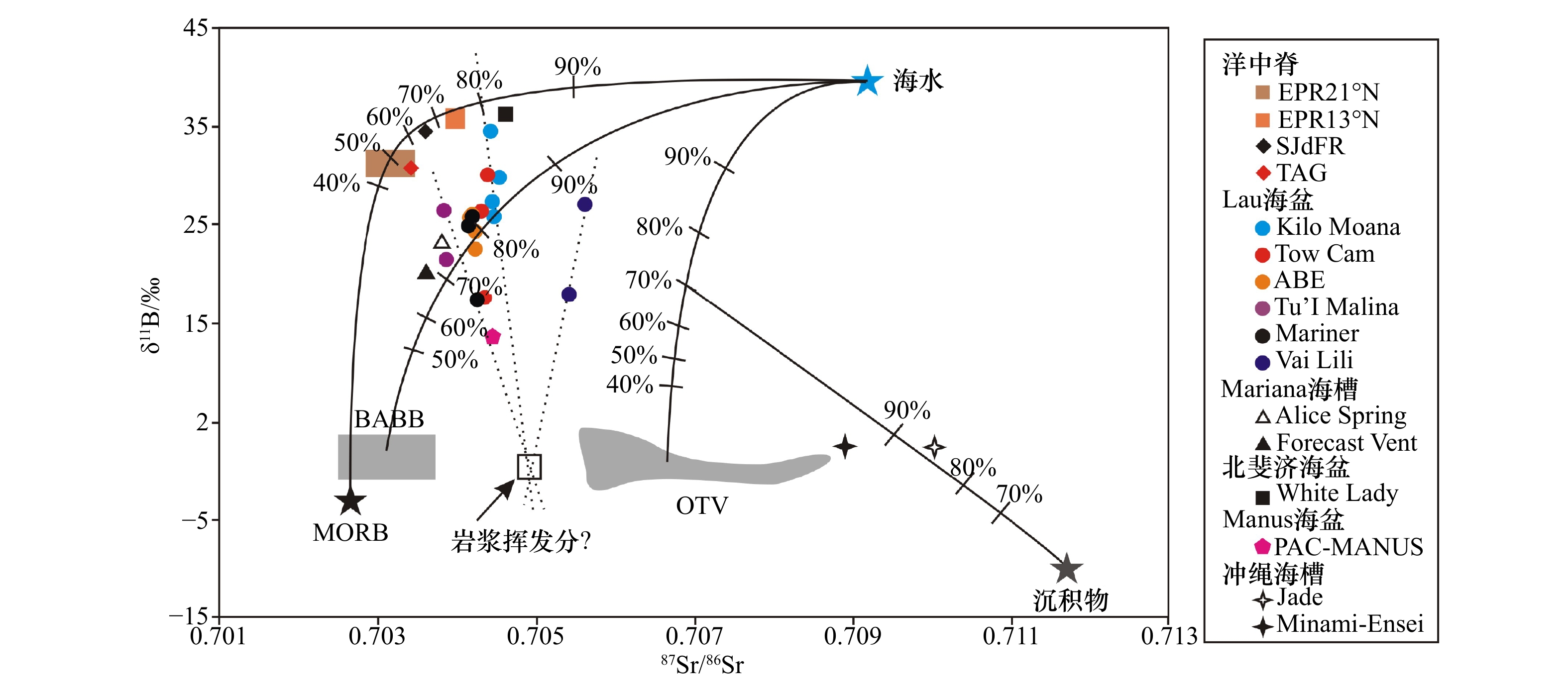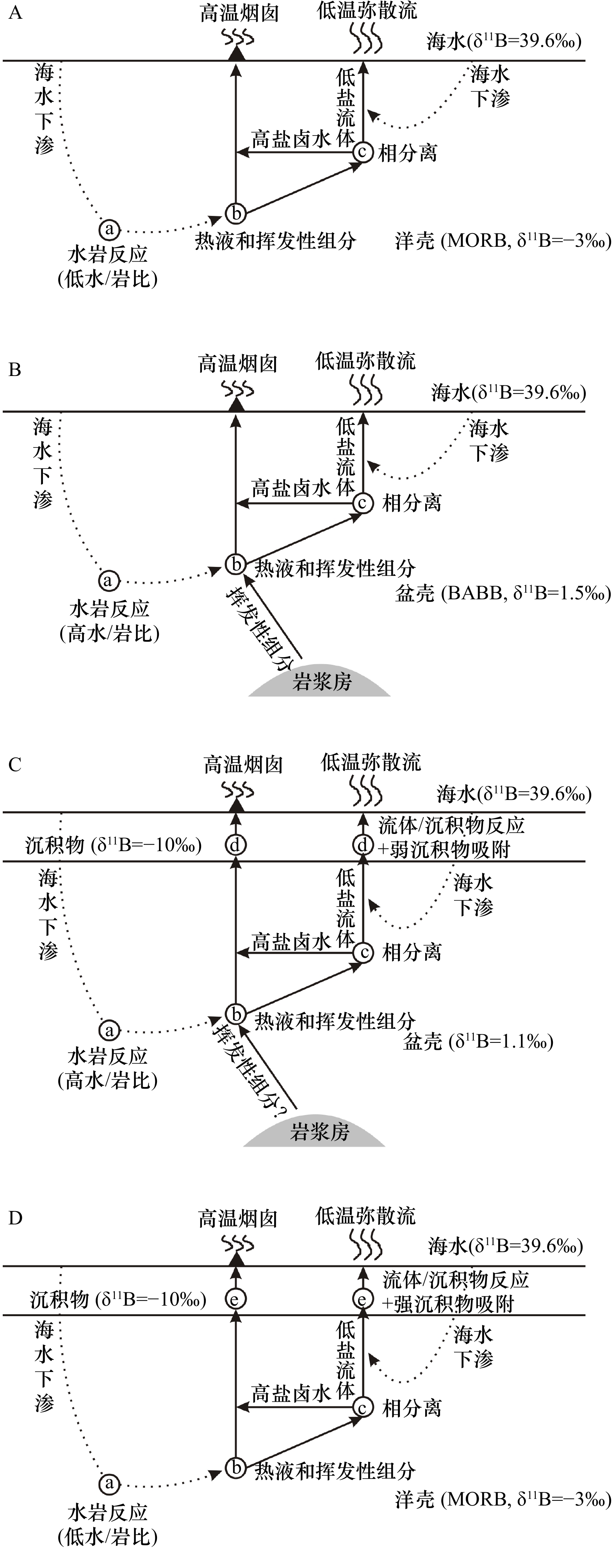Systematic differences in boron isotope compositions between mid-ocean ridge and back-arc basin hydrothermal fluids
-
摘要: 硼(B)是流体迁移元素,趋向于在热液流体中富集而成为常量元素。不同来源的B其同位素组成有着明显的区别。因此,B的含量及其同位素组成可标识热液流体(元素)的物质来源、水–岩反应程度及沉积物(元素)混入等重要过程,对海底热液活动及其成矿作用过程具有重要的示踪意义。迄今,对全球主要热液活动区热液流体中B的含量及同位素组成特征已做了大量的测试分析及研究工作,积累了丰富的资料和重要研究成果。但是,对不同地质背景(构造环境)条件下热液流体中B的含量及同位素组成特征尚缺乏系统性的对比分析,进而对造成不同环境热液流体中元素及其同位素组成的系统性差异的原因或机制尚缺乏深入的认识。本文在获取了洋中脊和弧后盆地主要热液活动区热液端元流体中B的含量及其同位素组成数据的基础上,定量估算了热液流体中B的主要来源,并对洋中脊和弧后盆地热液端元流体中B同位素组成的系统性差异进行了分析及成因探讨。结果表明,不同热液活动区热液端元流体的δ11B值都具有较大的变化范围,水–岩反应过程中不同来源B的混合是热液流体B同位素组成变化的主要原因。无沉积物覆盖的洋中脊和弧后盆地热液区热液流体中的B主要为海水与基底岩石来源B的混合,弧后盆地岩浆挥发性组分对热液系统的直接贡献及两种不同地质背景下基底岩石地球化学组成与水–岩反应程度的差异是其热液端元流体B同位素组成差异的主要原因。在有沉积物覆盖的弧后盆地热液区,热液流体中B的同位素组成与前两者之间存在显著差异,具有异常低的δ11B值,水–岩反应过程中沉积物来源B的加入是导致热液流体中δ11B值系统性降低的主要原因,沉积物的吸附作用也在一定程度上影响了热液流体的B同位素组成。有沉积物覆盖的洋中脊热液区热液流体同样受到了沉积物来源B加入的影响,具有较低的δ11B值,且相对于冲绳海槽受到了更强烈的沉积物吸附作用的影响。基于以上分析,并结合热液流体的Sr同位素组成特征,本文提出了洋中脊和弧后盆地这两大构造环境中热液流体B同位素组成系统性差异的成因模式。Abstract: Boron is a common element in vent fluids of seafloor hydrothermal fields. Due to its typical fluid-mobility and distinct isotope compositions in different reservoirs, boron has been largely applied to trace metal sources, water/rock interaction and sediment contribution to hydrothermal fluids. Up to date, the B contents and its isotope compositions in hydrothermal fluids from the major seafloor hydrothermal fields have been studied sufficiently, but the comparisons of B behavior in different geological settings are relatively limited and the reasons causing the systematic differences in elements and isotope compositions of hydrothermal fluids are still unclear. In this paper, the sources of B in hydrothermal fluids from different geological settings were calculated based on B contents and its isotope compositions, meanwhile, the causes of systematic differences in B isotope compositions between mid-ocean ridge and back-arc basin hydrothermal fluids were discussed. Results show that the δ11B values of hydrothermal end member fluids from different hydrothermal fields have large variations, which mainly results from the mixing of B from difference sources in different proportions. Boron in mid-ocean ridge and sediment-starve back-arc basin hydrothermal fluids are mainly from the mixing of seawater and basement-derived B, the contribution of magmatic volatiles to sediment-starve back-arc basin hydrothermal systems is the major causes of B isotope composition differences in these two geological settings. Moreover, the differences in geochemical compositions of basement rocks and degrees of water/rock interaction also cause the differences in B isotope compositions to some extent. While the δ11B values of hydrothermal end member fluids from sediment-covered hydrothermal fields are extremely low and contribution of sediment-derived B to hydrothermal fluid is the major cause of this phenomenon. Moreover, sediment absorption also causes the B isotope variation to some extent. In sediment-covered mid-ocean ridge hydrothermal fields, the B isotope compositions of hydrothermal fluids are also influenced by the incorporation of sediment-derived B and have relatively lower δ11B values. Compared with the Okinawa Trough, the degrees of sediment absorption in sediment-covered mid-ocean ridge hydrothermal fluids are more intensely. Based on these analysis, we put forward the mechanism causing systematic differences in B isotope compositions of hydrothermal fluids from mid-ocean ridge and back-arc basins.
-
图 3 主要热液活动区热液端元流体δ11B–Bsw/Bh相关图
Bsw、Bh分别为海水和热液端元流体中B的含量,Bsw/Bh=1代表海水端元,Bsw/Bh=0代表参与水–岩反应的岩石(+沉积物)端元
Fig. 3 The δ11B–Bsw/Bh diagram of the studied hydrothermal end-member fluid
Bsw and Bh indicate the B concentrations of seawater and hydrothermal end-member fluid. Bsw/Bh=1 indicates the seawater member and Bsw/Bh=0 indicates the rock (+sediment) member
图 5 洋中脊及弧后盆地热液流体B同位素组成系统性差异模式
A.无沉积物覆盖的洋中脊;B.无沉积物覆盖的弧后盆地;C.有沉积物覆盖的弧后盆地;D.有沉积物覆盖的洋中脊
Fig. 5 The schematic of the systematic differences in B isotope compositions between mid-ocean ridge and back-arc basins
A. Sediment-starve mid-ocean ridge; B. sediment-starve back-arc basins; C. sediment-covered back-arc basins; D. sediment-covered mid-ocean ridge
表 1 主要海底热液活动区热液端元流体中B的含量及B和Sr的同位素特征值
Tab. 1 Boron concentrations and B, Sr isotope compositions of the studied hydrothermal fluid
热液区 δ11B/‰ 87Sr/86Sr B含量/mmol·kg–1 数据来源 洋中脊热液区 EPR21°N 30.0~32.6 0.702 85~0.703 45 0.53 文献[4, 13, 15] EPR13°N 34.9~36.8 0.703 86~0.704 08 0.46 文献[22] SJdFR 34.5 0.703 6 TAG 30.9 0.703 4 0.36 Guaymas海盆 S热液区 17.4 1.60 文献[8] 19.6 1.68 E-Hill 16.5 1.55 Escanaba海槽 10.1 2.16 弧后盆地热液区 Lau海盆 Kilo Moana 25.7 0.704 46 0.54 文献[16] 27.2 0.704 45 0.51 29.5 0.704 53 0.55 34.3 0.704 42 0.54 Tow Cam 30.2 0.704 39 0.61 26.5 0.704 30 0.58 17.7 0.704 34 0.53 ABE 22.6 0.704 22 0.70 25.8 0.704 15 0.83 24.4 0.704 22 0.88 26.1 0.704 18 0.65 Tu’I Malina 21.5 0.703 85 0.76 26.4 0.703 82 0.92 Mariner 24.9 0.704 13 1.01 25.8 0.704 19 1.11 17.4 0.704 24 0.83 Vai Lili 18.0 0.705 40 0.81 27.0 0.705 60 0.61 Mariana海槽 Alice Spring 20.2 0.703 6 0.73 文献[12-13, 15] Forcast Vent 23.2 0.703 8 0.64 北斐济海盆 White Lady 36.1 0.704 6 0.44 文献[12, 15] Manus海盆 PAC-MANUS 13.5 0.704 29 1.47 文献[12, 23] 冲绳海槽 Jade 2.6 0.708 9 4.80 文献[8, 12, 14-15] Minami-Ensei 2.5 0.710 0 4.40 CLAM 9.2 2.73 7.0 2.77 表 2 主要物质端元的B和Sr的含量及其同位素组成特征值
Tab. 2 The B, Sr concentrations and their isotope compositions of the major end-members
-
[1] Bischoff J L, Dickson F W. Seawater-basalt interaction at 200℃ and 500 bars: Implications for origin of sea-floor heavy-metal deposits and regulation of seawater chemistry[J]. Earth and Planetary Science Letters, 1975, 25(3): 385−397. doi: 10.1016/0012-821X(75)90257-5 [2] Humphris S E, Thompson G. Hydrothermal alteration of oceanic basalts by seawater[J]. Geochimica et Cosmochimica Acta, 1978, 42(1): 107−125. doi: 10.1016/0016-7037(78)90221-1 [3] Mottl M J, Holland H D. Chemical exchange during hydrothermal alteration of basalt by seawater:Ⅰ. Experimental results for major and minor components of seawater[J]. Geochimica et Cosmochimica Acta, 1978, 42(8): 1103−1115. doi: 10.1016/0016-7037(78)90107-2 [4] Spivack A J, Edmond J M. Boron isotope exchange between seawater and the oceanic crust[J]. Geochimica et Cosmochimica Acta, 1987, 51(5): 1033−1043. doi: 10.1016/0016-7037(87)90198-0 [5] Spivack A J, Palmer M R, Edmond J M. The sedimentary cycle of the boron isotopes[J]. Geochimica et Cosmochimica Acta, 1987, 51(7): 1939−1949. doi: 10.1016/0016-7037(87)90183-9 [6] Spivack A J, You Chenfeng, Smith H J. Foraminiferal boron isotope ratios as a proxy for surface ocean pH over the past 21 Myr[J]. Nature, 1993, 363(6425): 149−151. doi: 10.1038/363149a0 [7] Morris J D, Leeman W P, Tera F. The subducted component in island arc lavas: constraints from Be isotopes and B-Be systematics[J]. Nature, 1990, 344(6261): 31−36. doi: 10.1038/344031a0 [8] You Chenfeng, Spivack A J, Smith J H, et al. Mobilization of boron in convergent margins: Implications for the boron geochemical cycle[J]. Geology, 1993, 21(3): 207−210. doi: 10.1130/0091-7613(1993)021<0207:MOBICM>2.3.CO;2 [9] You C F, Spivack A J, Gieskes J M, et al. Boron contents and isotopic compositions in pore waters: a new approach to determine temperature induced artifacts-geochemical implications[J]. Marine Geology, 1996, 129(3/4): 351−361. [10] Palmer M R, Sturchio N C. The boron isotope systematics of the Yellowstone National Park (Wyoming) hydrothermal system: A reconnaissance[J]. Geochimica et Cosmochimica Acta, 1990, 54(10): 2811−2815. doi: 10.1016/0016-7037(90)90015-D [11] Kasemann S A, Meixner A, Erzinger J, et al. Boron isotope composition of geothermal fluids and borate minerals from salar deposits (central Andes/NW Argentina)[J]. Journal of South American Earth Sciences, 2004, 16(8): 685−697. doi: 10.1016/j.jsames.2003.12.004 [12] Yamaoka K, Hong Ensong, Ishikawa T, et al. Boron isotope geochemistry of vent fluids from arc/back-arc seafloor hydrothermal systems in the western Pacific[J]. Chemical Geology, 2015, 392: 9−18. doi: 10.1016/j.chemgeo.2014.11.009 [13] Palmer M R. Boron-isotope systematics of Halmahera arc (Indonesia) lavas: Evidence for involvement of the subducted slab[J]. Geology, 1991, 19(3): 215−217. doi: 10.1130/0091-7613(1991)019<0215:BISOHA>2.3.CO;2 [14] You C F, Butterfield D A, Spivack A J, et al. Boron and halide systematics in submarine hydrothermal systems: Effects of phase separation and sedimentary contributions[J]. Earth and Planetary Science Letters, 1994, 123(1/3): 227−238. [15] Gamo T. Wide variation of chemical characteristics of submarine hydrothermal fluids due to secondary modification processes after high temperature water-rock interaction: a review[M]//Sakai H, Nozaki Y. Biogeochemical Processes and Ocean Flux in the Western Pacific. Tokyo: Terra Scientific Publishing Co., 1995: 425–451. [16] Mottl M J, Seewald J S, Wheat C G, et al. Chemistry of hot springs along the Eastern Lau Spreading Center[J]. Geochimica et Cosmochimica Acta, 2011, 75(4): 1013−1038. doi: 10.1016/j.gca.2010.12.008 [17] Zeng Zhigang, Wang Xiaoyuan, Chen C T A, et al. Boron isotope compositions of fluids and plumes from the Kueishantao hydrothermal field off northeastern Taiwan: Implications for fluid origin and hydrothermal processes[J]. Marine Chemistry, 2013, 157: 59−66. doi: 10.1016/j.marchem.2013.09.001 [18] Halbach P, Pracejus B, Maerten A. Geology and mineralogy of massive sulfide ores from the Central Okinawa Trough, Japan[J]. Economic Geology, 1993, 88(8): 2210−2225. doi: 10.2113/gsecongeo.88.8.2210 [19] Honma H, Kusakabe M, Kagami H, et al. Major and trace element chemistry and D/H, 18O/16O, 87Sr/86Sr and 143Nd/144Nd ratios of rocks from the spreading center of the Okinawa Trough, a marginal back-arc basin[J]. Geochemical Journal, 1991, 25(2): 121−136. doi: 10.2343/geochemj.25.121 [20] Shinjo R, Kato Y. Geochemical constraints on the origin of bimodal magmatism at the Okinawa Trough, an incipient back-arc basin[J]. Lithos, 2000, 54(3/4): 117−137. [21] Halbach P, Hansmann W, Köppel V, et al. Whole-rock and sulfide lead-isotope data from the hydrothermal JADE field in the Okinawa back-arc trough[J]. Mineralium Deposita, 1997, 32(1): 70−78. doi: 10.1007/s001260050073 [22] 曾志刚. 海底热液地质学[M]. 北京: 科学出版社, 2011.Zeng Zhigang. Submarine Hydrothermal Geology[M]. Beijing: Science Press, 2011. [23] Reeves E P, Seewald J S, Saccocia P, et al. Geochemistry of hydrothermal fluids from the PACMANUS, northeast Pual and Vienna woods hydrothermal fields, Manus Basin, Papua New Guinea[J]. Geochimica et Cosmochimica Acta, 2011, 75(4): 1088−1123. doi: 10.1016/j.gca.2010.11.008 [24] Kanzaki T, Yoshida M, Nomura M, et al. Boron isotopic composition of fumarolic condensates and sassolites from Satsuma Iwo-Jima, Japan[J]. Geochimica et Cosmochimica Acta, 1979, 43(11): 1859−1863. doi: 10.1016/0016-7037(79)90035-8 [25] Nomura M, Kanzaki T, Ozawa T, et al. Boron isotopic composition of fumarolic condensates from some volcanoes in Japanese island arcs[J]. Geochimica et Cosmochimica Acta, 1982, 46(11): 2403−2406. doi: 10.1016/0016-7037(82)90212-5 [26] Rollion-Bard C, Blamart D, Trebosc J, et al. Boron isotopes as pH proxy: A new look at boron speciation in deep-sea corals using 11B MAS NMR and EELS[J]. Geochimica et Cosmochimica Acta, 2011, 75(4): 1003−1012. doi: 10.1016/j.gca.2010.11.023 [27] Pagani M, Lemarchand D, Spivack A, et al. A critical evaluation of the boron isotope-pH proxy: The accuracy of ancient ocean pH estimates[J]. Geochimica et Cosmochimica Acta, 2005, 69(4): 953−961. doi: 10.1016/j.gca.2004.07.029 [28] Kakihana H, Kotaka M, Satoh S, et al. Fundamental studies on the ion-exchange separation of boron isotopes[J]. Bulletin of the Chemical Society of Japan, 1977, 50(1): 158−163. doi: 10.1246/bcsj.50.158 [29] Liebscher A, Meixner A, Romer R L, et al. Liquid-vapor fractionation of boron and boron isotopes: Experimental calibration at 400℃/23 MPa to 450℃/42 MPa[J]. Geochimica et Cosmochimica Acta, 2005, 69(24): 5693−5704. doi: 10.1016/j.gca.2005.07.019 [30] Eissen J P, Lefe'vre C, Maillet P, et al. Petrology and geochemistry of the central North Fiji Basin spreading centre (Southwest Pacific) between 16°S and 22°S[J]. Marine Geology, 1991, 98(2/4): 201−239. [31] Eissen J P, Nohara M, Cotten J, et al. North Fiji Basin basalts and their magma sources: Part Ⅰ. Incompatible element constraints[J]. Marine Geology, 1994, 116(1/2): 153−178. [32] Nohara M, Hirose K, Eissen J P, et al. The North Fiji Basin basalts and their magma sources: Part Ⅱ. Sr-Nd isotopic and trace element constraints[J]. Marine Geology, 1994, 116(1/2): 179−195. [33] Sun S S, Mcdonough W F. Chemical and isotopic systematics of oceanic basalts: implications for mantle composition and processes[J]. Geological Society, London, Special Publications, 1989, 42(1): 313−345. doi: 10.1144/GSL.SP.1989.042.01.19 [34] Hart S R, Blusztajn J, Dick H J B, et al. The fingerprint of seawater circulation in a 500-meter section of ocean crust gabbros[J]. Geochimica et Cosmochimica Acta, 1999, 63(23/24): 4059−4080. [35] Escrig S, Bézos A, Goldstein S L, et al. Mantle source variations beneath the Eastern Lau Spreading Center and the nature of subduction components in the Lau basin-Tonga arc system[J]. Geochemistry, Geophysics, Geosystems, 2013, 10(4): Q04014. [36] Peate D W, Kokfelt T F, Hawkesworth C J, et al. U-series isotope data on Lau Basin glasses: the role of subduction-related fluids during melt generation in back-arc basins[J]. Journal of Petrology, 2001, 42(8): 1449−1470. doi: 10.1093/petrology/42.8.1449 [37] Hergt J M, Woodhead J D. A critical evaluation of recent models for Lau-Tonga arc-backarc basin magmatic evolution[J]. Chemical Geology, 2007, 245(1/2): 9−44. [38] Fretzdorff S, Schwarz-Schampera U, Gibson H L, et al. Hydrothermal activity and magma genesis along a propagating back-arc basin: Valu Fa Ridge (southern Lau Basin)[J]. Journal of Geophysical Research: Solid Earth, 2006, 111(B8): B08205. [39] Volpe A M, Macdougall J D, Lugmair G W, et al. Fine-scale isotopic variation in Mariana Trough basalts: evidence for heterogeneity and a recycled component in backarc basin mantle[J]. Earth and Planetary Science Letters, 1990, 100(1/3): 251−264. [40] Stem R J, Lin Pingnan, Morris J D, et al. Enriched back-arc basin basalts from the northern Mariana Trough: implications for the magmatic evolution of back-arc basins[J]. Earth and Planetary Science Letters, 1990, 100(1/3): 210−225. [41] 李正刚. 西南太平洋弧后盆地岩石地球化学及其成矿指示意义[D]. 杭州: 国家海洋局第二海洋研究所, 2011.Li Zhenggang. Geochemistry of back-arc basin volcanic rocks, Southwest Pacific: Implication for sea-floor mineralization[D]. Hangzhou: The Second Institute of Oceanography, State Oceanic Administration, 2011. [42] Zhang Xia, Zhai Shikui, Yu Zenghui, et al. Subduction contribution to the magma source of the Okinawa Trough: Evidence from boron isotopes[J]. Geological Journal, 2018, 54(1): 605−613. doi: 10.1002/gj.3209 [43] Guo Kun, Zhai Shikui, Yu Zenghui, et al. Geochemical and Sr-Nd-Pb-Li isotopic characteristics of volcanic rocks from the Okinawa Trough: implications for the influence of subduction components and the contamination of crustal materials[J]. Journal of Marine Systems, 2018, 180: 140−151. doi: 10.1016/j.jmarsys.2016.11.009 [44] 国坤. 冲绳海槽火山岩浆源区组成及俯冲组分影响的研究[D]. 青岛: 中国海洋大学, 2016.Guo Kun. Research on volcanic rock magma source composition and subduction composition effects in Okinawa Trough[D]. Qingdao: Ocean University of China, 2016. [45] Plank T, Langmuir C H. The chemical composition of subducting sediment and its consequences for the crust and mantle[J]. Chemical Geology, 1998, 145(3/4): 325−394. [46] Hauff F, Hoernle K, Schmidt A. Sr-Nd-Pb composition of Mesozoic Pacific oceanic crust (Site 1149 and 801, ODP Leg 185): Implications for alteration of ocean crust and the input into the Izu-Bonin-Mariana subduction system[J]. Geochemistry, Geophysics, Geosystems, 2003, 4(8): 8913. [47] Ishizuka O, Taylor R N, Yuasa M, et al. Processes controlling along-arc isotopic variation of the southern Izu-Bonin arc[J]. Geochemistry, Geophysics, Geosystems, 2007, 8(6): Q06008. [48] Shu Yunchao, Nielsen S G, Zeng Zhigang, et al. Tracing subducted sediment inputs to the Ryukyu arc-Okinawa Trough system: Evidence from thallium isotopes[J]. Geochimica et Cosmochimica Acta, 2017, 217: 462−491. doi: 10.1016/j.gca.2017.08.035 [49] Tonarini S, Agostini S, Doglioni C, et al. Evidence for serpentinite fluid in convergent margin systems: The example of El Salvador (Central America) arc lavas[J]. Geochemistry, Geophysics, Geosystems, 2007, 8(9): Q09014. [50] Scambelluri M, Tonarini S. Boron isotope evidence for shallow fluid transfer across subduction zones by serpentinized mantle[J]. Geology, 2012, 40(10): 907−910. doi: 10.1130/G33233.1 [51] Kim J, Lee I, Lee K Y. S, Sr, and Pb isotopic systematics of hydrothermal chimney precipitates from the Eastern Manus Basin, western Pacific: Evaluation of magmatic contribution to hydrothermal system[J]. Journal of Geophysical Research: Solid Earth, 2004, 109(B12): B12210. doi: 10.1029/2003JB002912 [52] Yang Kaihui, Scott S D. Magmatic sources of volatiles and metals for volcanogenic massive sulfide deposits on modern and ancient seafloors: Evidence from melt inclusions[M]//Mao J, Bierlein F P. Mineral Deposit Research: Meeting the Global Challenge. Berlin Heidelberg: Springer, 2005: 715-718. [53] 王淑杰, 翟世奎, 于增慧, 等. 关于现代海底热液活动系统模式的思考[J]. 地球科学, 2018, 43(3): 835−850.Wang Shujie, Zhai Shikui, Yu Zenghui, et al. Reflections on model of modern seafloor hydrothermal system[J]. Earth Science, 2018, 43(3): 835−850. [54] Yu Zenghui, Zhai Shikui, Guo Kun, et al. Helium isotopes in volcanic rocks from the Okinawa Trough—impact of volatile recycling and crustal contamination[J]. Geological Journal, 2016, 51(S1): 376−386. -





 下载:
下载:




